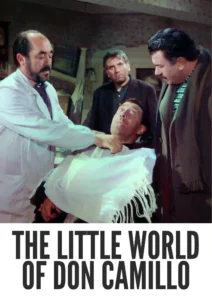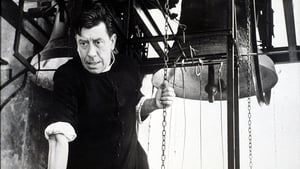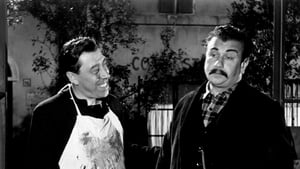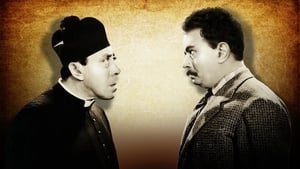Video Sources 0 Views

Download The Little World of Don Camillo (1952) Colorized HD | Fernandel | Pastoral Comedy Classic
Synopsis

Step into the idyllic, yet comically contentious, world of post-war rural Italy with The Little World of Don Camillo, a heartwarming pastoral comedy from 1952, now beautifully colorized for an engaging viewing experience. This film, starring Fernandel and Gino Cervi, delivers a delightful blend of humor, faith, and small-town politics. Perfect for those seeking a feel-good classic with memorable characters, this HD download brings a timeless story of rivalry and reconciliation to your screen.
The Little World of Don Camillo revolves around the ongoing feud between Don Camillo (Fernandel), the fiery and headstrong Catholic priest, and Giuseppe “Peppone” Bottazzi (Gino Cervi), the equally stubborn Communist mayor of a small Italian town. Their opposing ideologies and strong personalities clash constantly, leading to humorous and often absurd situations.
From arguments over church bells to disagreements on local policies, Don Camillo and Peppone are always at odds. However, beneath their political rivalry lies a deep-seated respect and even affection for each other. Both men are dedicated to the well-being of their community, and their actions, though often misguided, are driven by a genuine desire to do what they believe is best. The film explores themes of faith, politics, and the human capacity for understanding and forgiveness, all set against the backdrop of a picturesque Italian village. Ultimately, The Little World of Don Camillo is a heartwarming and entertaining film that celebrates the importance of community and the power of reconciliation.
The film features a stellar cast of actors who bring these beloved characters to life:
-
Fernandel as Don Camillo
-
Gino Cervi as Giuseppe “Peppone” Bottazzi
-
Sylvie as Signora Cristina
-
Carlo Taranto as The Intellectual
-
Marco Tulli as Lo Smilzo
The Little World of Don Camillo falls into the genre of pastoral comedy, with elements of social commentary and heartwarming drama. Its charming characters, picturesque setting, and universal themes make it a timeless and beloved film.
Released in 1952, The Little World of Don Camillo reflects the social and political climate of post-war Italy, where the country was grappling with rebuilding and ideological divisions. The film’s depiction of the rivalry between the Church and the Communist Party resonated with audiences who were experiencing similar tensions in their own lives. However, the film also offered a sense of escapism, transporting viewers to a simpler, more idyllic world where conflicts could be resolved through humor and understanding. The Little World of Don Camillo was a major commercial success, spawning a series of sequels and solidifying its place in Italian cinema history.
This colorized version of The Little World of Don Camillo has been meticulously restored using modern digital techniques, enhancing the visual appeal while preserving the film’s original charm and atmosphere. The colorization process involved carefully analyzing the grayscale tones of the original black and white footage and assigning appropriate colors to each scene. This painstaking process brings new life to the characters and landscapes, making the story even more engaging for modern audiences. While the debate around colorizing classic films continues, this version introduces The Little World of Don Camillo to a new generation, ensuring its legacy for years to come.
-
: Julien Duvivier
-
: Julien Duvivier, Giovanni Guareschi
-
: the stories by Giovanni Guareschi
-
: Nicolas Hayer
-
: Marguerite Renoir
-
: Rizzoli Film
-
: Rank Film Organization
-
: 93 minutes
-
: MP4
-
: HD (1080p)
-
: Compatible with most devices, including smartphones, tablets, computers, and smart TVs.
The Little World of Don Camillo (1952) is widely regarded as a classic of Italian cinema, celebrated for its humor, heart, and memorable characters. The film was a major commercial success, both in Italy and internationally, and it has been praised for its portrayal of rural Italian life and its exploration of universal themes. While some critics have noted the film’s simplistic depiction of political ideologies, The Little World of Don Camillo remains a beloved and enduring cinematic achievement.
-
: What is The Little World of Don Camillo about?
-
A: The Little World of Don Camillo is a comedy about the rivalry between a Catholic priest and a Communist mayor in a small Italian town.
-
-
: Is The Little World of Don Camillo (1952) a well-known film?
-
A: Yes, The Little World of Don Camillo is a classic of Italian cinema and is widely recognized for its humor and heart.
-
-
: Is this version of The Little World of Don Camillo colorized?
-
A: Yes, this version has been professionally colorized to enhance the viewing experience.
-
-
: What makes The Little World of Don Camillo so beloved?
-
A: The Little World of Don Camillo is beloved for its charming characters, picturesque setting, and universal themes of faith, politics, and reconciliation.
-
-
: What is the download format?
-
A: The download format is MP4, which is compatible with most devices.
-
-
: What resolution is the download?
-
A: The resolution is HD (1080p), providing a high-quality viewing experience.
-
Watch The Little World of Don Camillo Today! Also known as: Don Camillo and Peppone, Le Petit Monde de Don Camillo.













